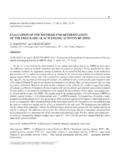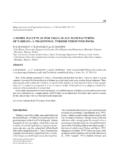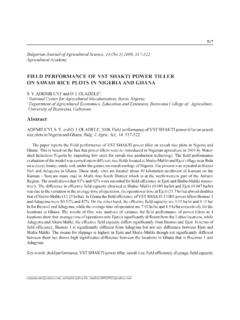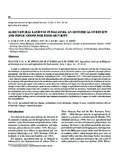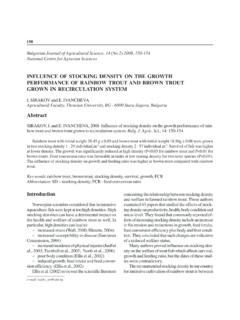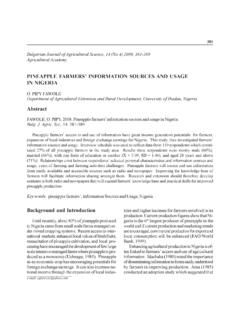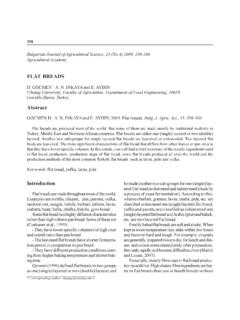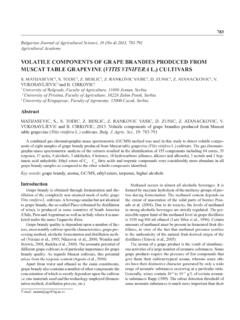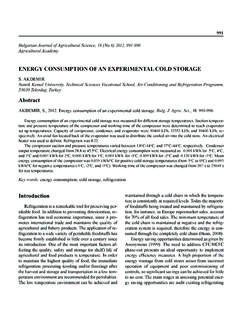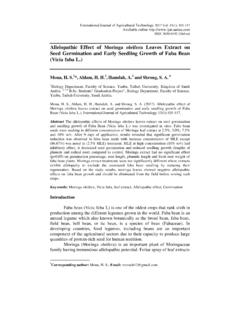Transcription of EFFECT OF DEFOLIATION BASED ON LEAF POSITION ON …
1 801 EFFECT OF DEFOLIATION BASED ON LEAF POSITION ON MAIZE yield , yield COMPONENTS AND produced seed GERMINATIONH. HEIDARIRazi University, Department of Crop Production and Plant Breeding, Faculty of Agriculture, 67149-67346 Kermanshah, IranAbstractHEIDARI, H., 2015. EFFECT of DEFOLIATION BASED on leaf POSITION on maize yield , yield components and produced seed germination . Bulg. J. Agric. Sci., 21 801 805 DEFOLIATION can affect maize seed yield . In order to determine the EFFECT of DEFOLIATION treatments on maize yield , yield components and produced seed germination traits, a field and a laboratory experiments were conducted in 2012. The field ex-periment included six DEFOLIATION treatments (D1= control, no leaf removal, D2 = defoliating tassel leaf, D3 = defoliating ear leaf, D4 = defoliating leaves at the top of the ear, D5 = defoliating leaves under ear, D6 = defoliating all leaves).
2 germination traits of seed produced from maternal plant were tested at the laboratory experiment. Results showed that complete defolia-tion severely reduced seed yield , row number per ear, seed number per ear, cob length, cob weight and ear weight (P < 5%). DEFOLIATION treatments had minor EFFECT on produced seed germination words: DEFOLIATION , leaf POSITION , maternal EFFECT , seed vigor, yield componentsBulgarian Journal of Agricultural Science, 21 (No 4) 2015, 801-805 Agricultural AcademyE-mail: Several biotic and abiotic stresses affect maize yield through DEFOLIATION . These stresses are insects, rust, hail, her-bivores, herbicides and farm machinery. Sunflower (Helian-thus annuus L.)
3 Yields were severely reduced by DEFOLIATION at the preflowering stage (Erbas and Baydar, 2007). Zewdu and Asregid (2001) reported that critical rate of DEFOLIATION in maize that did not affect seed yield and yield components is 50%. Other researchers have declared a significant EFFECT of DEFOLIATION on maturity and soluble solid content (Tollenaar and Daynard, 1987) in maize. Maize (Zea mays) plants under complete DEFOLIATION had the lowest seed yield , ear weight, row number per ear, cob weight and 100- seed weight, but had higher seed germination percentage, rate and vigor (Heidari, 2013). In common vetch (Vicia sativa), plants under different DEFOLIATION produced seeds with similar germination percent-age (Koptur, et al.)
4 , 1996). Maize production of Iran was 1 930 000 tons in 2005 (Magiran, 2012 ). In west of Iran, foliage losses from some insects, diseases and herbivores is notice-able. The objective of this study was to determine maize seed yield and seed germination traits as affected by DEFOLIATION at different leaf and Methods Experiment 1: Field ExperimentSite, experimental design and cultural practicesThe field experiment was conducted at Chamchamal plain, 47 km from Kermanshah, west of Iran in 2012 (Lati-tude 34 N, longitude 47 E, and altitude 1300 m above sea level). Average annual rainfall of the zone is 442 mm (IMO, 2012). The experimental design was a randomized complete block design (RCBD) with three replications.
5 There were six DEFOLIATION treatments: D1= control, no leaf removal, D2 = defoliating tassel leaf, D3 = defoliating ear leaf, D4 = defoliating leaves at the top of the ear, D5 = defoliating leaves under ear, D6 = defoliating all leavesMaize seeds (Zea mays, cv 704) were sown on April 18, 2012 using a pneumatic maize seeder. Seeding rate was 25 kg ha-1. Plants were irrigated 4 times. Urea fertilizer [46 = N%, CO (NH2)2] at 250 kg ha-1, was applied as top dressing. Weeds were controlled by Nicosulfuron (Cruz) herbicide (2-[[[[4,6-dimethoxy-2-pyrimidinyl) amino] carbonyl] ami-no] sulfonyl] N, N-dimethyl-3-pyridinecarboxamide) and 2,4-D + MCPA herbicide ((2, 4-dichlorophenoxy acetic acid H.)
6 Heidari802in ammonium (amine) salt: 2, 4-D; 4-chloro-2-methylphe-noxy) acetic acid: MCPA).Plot size was 3 m wide and 3 m long. The distances be-tween plots and between replications were both m. De-foliation treatments were imposed at silking stage (91 days after sowing). Plant sampling and measurementsIn order to measure the seed yield , five plants were cut and after drying, seed yield was measured as gram per plant. Plants were harvested when they yellowed. Row number per cob, seed number per row and cob length was measured by random selection of three ears per plot. Cob weight, ear skin weight, ear weight and 100- seed weight were measured by random selec-tion of five plants per plot after drying the plant part.
7 Experiment 2: Laboratory ExperimentSeeds of maternal plants were stored for 3 weeks. Then they were used for the laboratory experiment. In the labo-ratory experiment, the EFFECT of maternal environment was studied by testing seed germination traits. The study was conducted as a Randomized Complete Block Design with three replications in fall 2012. At first, seeds were sterilized using sodium hypochlorite solution (1% active chlorine) for 10 min to avoid fungal con-tamination. Then each Petri dish received ten seeds and 10 ml of distilled water. Finally, Petri dishes were kept in a growth chamber at 25oC. The criterion for germination was two mil-limeters growth of coleoptiles.
8 The trial period was 7 days. seed vigor was estimated using the formulae (Heidari, 2012; Sharifzadeh et al., 2006): seed vigor (% cm) = [Radicle length (cm) + Caulicle length (cm)] * [% germination ] seed vigor (% g) = [Radicle weight (g) + Caulicle weight (g)] * [% germination ] Data analysisData were analyzed using analysis of variance. Duncan test was used to separate the means ((P < ). MINITAB (version ), SAS (version ) and SPSS (version ) were used for statistical and Discussions Experiment 1 Ear skin weight and ear weightRemoving all leaves severely reduced ear weight (Table 1). Ear leaf removal had higher ear weight than defoliating leaves under and at the top of the ear.)
9 Maybe it is due to that ear leaf acts as a parasite for ear growth at grain filling pe-riod because it is located in central part of maize stem and upper leaves can shade on it. DEFOLIATION treatments had no significant EFFECT on ear skin weight (Table 1). Ear weight and ear skin weight had a significant and positive correlation with all traits except 100- seed weight (Table 2). Some parts of the results are in compatible with Barimavandi et al. (2010) and Heidari (2013) results. Reduction in leaf area reduces re-sources for grain filling (Koptur et al., 1996).Row number per ear and seed number per rowComplete DEFOLIATION severely reduced row number per ear and seed number per row (Table 1).
10 Brimavandi et al. (2010) and Heidari (2013) reported that the row number per ear only was affected by complete DEFOLIATION . Minor EFFECT of DEFOLIATION on seed number per row and row number per ear is due to that stem reserves can compensate insufficient Table 1 EFFECT of DEFOLIATION treatments on maize yield and yield componentsTreatmentsEar weight, g/plant bEar skin weight, g/plantRow number per earSeed number per rowCob length, cmCob weight, g/plantSeed yield , g/plant100- seed weight, abc a a ab ab a abc a ab a a 47. 7 a a a ab 18. 7 a a a a a a a a 20.
